This is a long post describing how a group of concerned people, including myself, noticed some unusual plastic pellets appearing on several beaches in the vicinity of Charmouth in west Dorset in the south west of the UK. After a tortuous investigation, we identified the source of the plastic pellet pollution as a local water company carelessly and unnecessarily discharging the pellets into the sea.
The story started on a sultry day in late July 2017. I was driving back from the Wareham area where I had been walking across one of the remaining fragments of Thomas Hardy’s Egdon Heath, the fictional landscape that plays so important a part in his novel The Return of the Native. I found myself approaching Charmouth, a small village in west Dorset and decided I needed a cup of tea. Charmouth village lies a short distance inland from the sea and Charmouth beach is popular with families in the summer, the cliffs are famous for their fossils and in her novel Persuasion, Jane Austen refers to “its sweet, retired bay, backed by dark cliffs”.
I was the only customer in the Bank House Café that afternoon and as I waited for my tea, I noticed some copies of the village magazine, Shoreline. I picked one up and started to leaf through. It’s an interesting read but my attention was taken by an article about “nurdles” written by Eden Thomson, a volunteer at the local Heritage Centre that organises marine and fossil events. I quickly learnt that nurdles are pre-production plastic pellets used as easily transportable raw materials in the plastics industry where they are used to make many of the plastic goods we have become accustomed to. There is considerable loss of these pellets during transport and during use. Some of these lost pellets end up in the sea and Eden reported finding large numbers of turquoise pellets on the beach at Charmouth with light grey and dark grey also being common. I didn’t have time to go to the beach to look that day but my curiosity was piqued.
Looking for pellets
Now, when we walked on beaches, both Hazel and I looked to see if we could find any plastic pellets. It took me a while to get my eye in, Hazel saw them more quickly, but gradually I noticed a few pellets on most beaches. My first big find was at Leas Foot Sands near Thurlestone in south Devon after some hefty storms in mid October 2017 where hundreds were sprinkled along the strandlines. These were all 5mm or less across, some were lentil shaped and translucent, many were cylindrical and grey and a few were irregular grey and black with clear ridges. By reference to the Great Nurdle Hunt web site I reckoned most were nurdles but a few might be biobeads (see below).
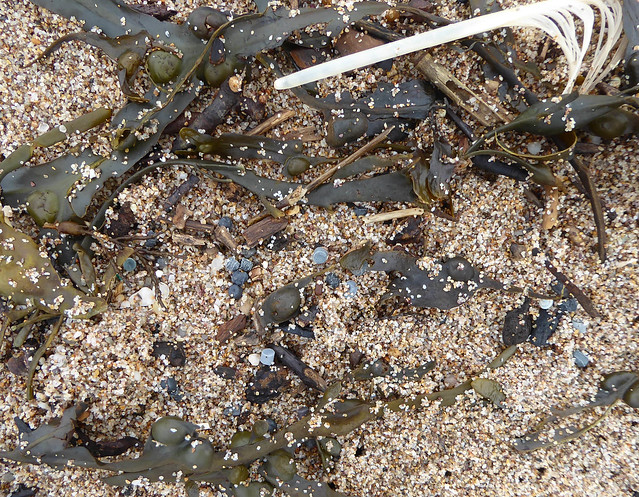
Then in late October 2017 I had a chance to return to Charmouth and look at the beach. Not only was there a lot of general plastic pollution among reedy/woody debris either side of the river Char where it approaches the beach, but among this debris were many plastic pellets. There were a few of the translucent or yellow or green lentil shaped pellets, also some grey or black cylindrical pellets. Most of these were nurdles. Also, as Eden Thomson had described, there were many bright blue cylindrical pellets. When I examined these, I felt they were quite different from other pellets I had seen; in particular they had many fine ridges and I thought they might be biobeads (see below). We returned to Charmouth in January 2018 and again found many of the bright blue ridged pellets littered around the two sides of the river and on the car park edges. We also made a brief visit to West Bay, about 7 miles to the east of Charmouth and found many bright blue ridged pellets there as well.
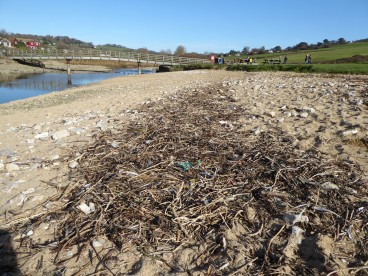

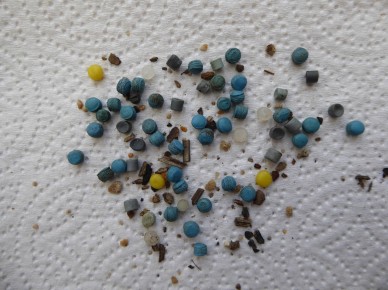
Dawlish Warren is another beach where we find plastic debris especially after storms and we had a look for pellets in March 2018. We found them distributed along both inner and outer beaches, they were mostly cylindrical, pale blue, grey and green but there were a few knobbly dark grey pellets, some also having ridges. We also found a few of the bright blue ridged pellets seen at Charmouth.
Trying to understand
In trying to understand these observations, I was greatly helped by the influential report from the Cornish Plastic Pollution Coalition (CPPC) lead by Claire Wallerstein. The CPPC had found huge numbers of black plastic pellets further west along beaches in Cornwall and, following extensive investigation, showed that these were biobeads, plastic pellets used in some sewage plants to promote sewage digestion and water purification. Biobeads are usually ridged or knobbly to provide a greater surface area for bacteria to grow and help digest the sewage. The CPPC showed that most likely the biobeads they found on beaches were escaping from biobead-dependent sewage plants run by South West Water, the local water purification and sewage company.
Based on their findings, I worked out that I was collecting both nurdles (preproduction plastic pellets) and biobeads. For the most part when I collected pellets from beaches in Devon, I found mixtures of nurdles of different shapes and colours together with a few black knobbly biobeads. At Charmouth and West Bay in Dorset, however, the predominant pellet was bright blue, cylindrical with fine ridges, typical of a biobead. There were definitely also some black knobbly biobeads on the beach at Charmouth. The four pictures below showing samples of pellets collected from two regions of Dawlish Warren beach in Devon and two sides of Charmouth Beach illustrate these differences quite well.


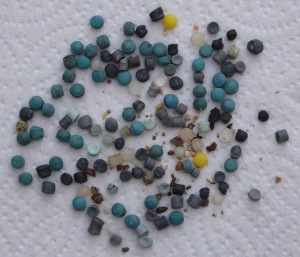

So, did South West Water (SWW) have a role in the biobead pollution appearing on Charmouth beach? The company runs a sewage works in nearby Lyme Regis based on biobead digestion. The actual works is located in Sleech Wood above the town but the purified sewage effluent is discharged into the sea some distance off the town of Lyme Regis below the Cardinal Buoy. I began to develop a working hypothesis whereby SWW uses these blue biobeads and probably also the black knobbly equivalent in their Sleech Wood works but containment of biobeads is incomplete and some are discharged into the sea and are washed back on to Charmouth and West Bay beaches. Another possibility was that pellets were being lost into the river Lim, which passes near the sewage works, to enter the sea with the river water.
A Nurdle Hunt
In the meantime, I took part in a nurdle hunt on Charmouth Beach organised by Sophie Thomas from the Charmouth Heritage Centre one Saturday in February 2018. There were 30 nurdle hunters on a bright sunny morning including Eden Thomson who wrote the article in Shoreline Magazine and it was good to meet her. It was also good to meet blogging friend Sarah West from Transition Town Bridport and her husband John. Altogether we collected 6650 pellets many of which were bright blue biobeads although a few black knobbly biobeads were mixed in with the blues. It is my impression that the black type may often be ignored in favour of the much more visible bright blue pellet.
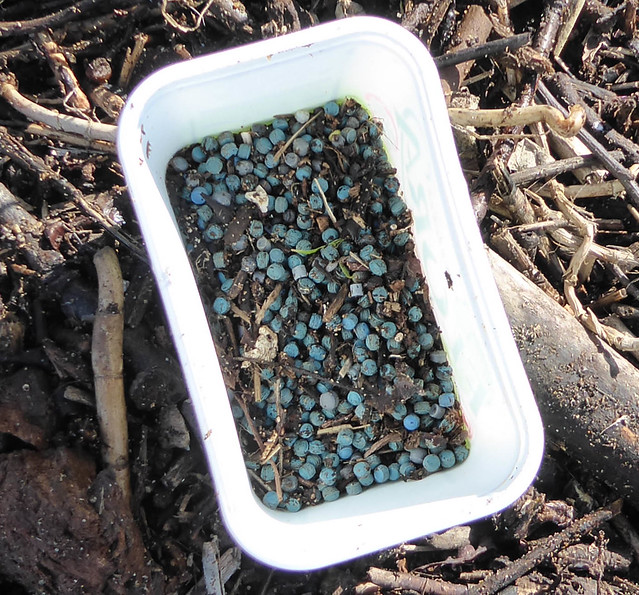
I wrote an article for the local Marshwood Vale Magazine describing the nurdle hunt and its background. This was published in May 2018 and soon after, I was contacted by Joe Hackett of Transition Town Bridport who had organised a beach clean at West Bay (seven miles east of Charmouth) and found many bright blue pellets there. He had noted the similarity between the pellets found at West Bay and Charmouth and wondered if we could discuss the situation. We spoke by phone and have been in contact since then.
Frustration
In March and April 2018, I became very frustrated at my inability to tie down the nature and the origin of these blue and black biobeads. I had contacted various academic experts, pressure groups and one local plastics company to ask if they could help me understand the nature of the pellets and the background to what was going on. I was very surprised to find that none of these people was prepared to get involved. Of all the people I contacted, only one replied and she was “too busy to help”.
I did investigate one possible hypothesis, namely that the biobeads were being lost from the Lyme Regis sewage works into the river Lim. I walked along the river Lim in Lyme Regis to see if any pellets were visible at the river’s edge but found none suggesting that this route was unlikely. When I talked to Joe Hackett, it turned out he had done the same accompanied by local environmentalist, Horatio Morpurgo. They also found nothing suggesting that pellets were not being lost in to the river Lim. This meant that most likely the biobeads were being discharged into the sea along with the treated sewage.
Claire Wallerstein from the CPPC offered to ask SWW what biobeads they used at their Lyme Regis sewage works and was told, “we don’t know and it would cost too much to use a crane to lift the lid to check”.
I enter the South West Water labyrinth
In desperation, I contacted the South West Water (SWW) Press Office in May 2018 and my enquiry was forwarded to Paul McNie, Environmental Manager of Waste Water Customer Service & Networks. I received a reply from Gavin Lincoln, Wastewater Treatment Process Consultant, asking what I wanted to know. I sent him a list of questions about biobead-dependent sewage treatment including asking what type of biobead was used at Lyme Regis but heard nothing. After discussions with Joe Hackett and Horatio Morpurgo, I wrote a paper letter to McNie in July 2018 asking about the nature of the biobeads used at the Lyme Regis Sewage Works. This occasioned a reply from Sue Richards, Customer Manager for SWW towards the end of July introducing herself as my dedicated case manager (it felt as though my enquiry ranked at about the same level as a leaking water pipe). I received a second letter in early August from Katie Hudson, also a Customer Services manager telling me that Paul McNie would be in touch about my queries. He never did get back to me and the rest of my interactions with SWW were through Sue Richards who, although courteous and helpful, appeared to be poorly briefed as she made some obvious errors of fact in her letters to me. The saga continued in this vein but she did reveal that the biobeads used at Lyme Regis were “black with a hint of blue” and after I asked what this meant she sent me a low-resolution photo printed on letter paper showing the biobeads used there. They all appeared to be black and strongly resembled one class of biobead found at Charmouth as well as the majority of those found by CPPC in Cornwall. I spoke to Sue Richards by phone several times and raised the issue of the blue biobeads only to have the conversation closed down quickly.
To summarise, SWW told us three contradictory stories:
- They didn’t know the nature of the biobeads used at Lyme Regis sewage works (via Claire Wallerstein)
- The biobeads used are black with a hint of blue
- The biobeads used are black and knobbly
This was all very confusing and I was left not knowing what to believe.
Living the high life – visits to the sewage works
In the meantime, Joe Hackett had been busy organising visits to Exmouth and Lyme Regis sewage works as it was felt that this was our last chance to understand what was going on. The Cornish Plastic Pollution Coalition had visited the Plympton sewage works early in 2017 and found biobeads littered about the site. This was a key piece of information linking poor biobead housekeeping by SWW at the Plympton sewage works to the extensive biobead pollution on Cornish beaches.
The Exmouth visit took place in November 2018 but I was unable to be there. Those that visited had an interesting time and learnt about the basics of the biobead sewage treatment. They did not find any biobeads loose on the site but noticed a huge pile of used/depleted biobeads, the size of two buses, covered with sheeting. The SWW representative expressed his frustration over the problems the company faced with biobeads in the following admission “If we’d had a crystal ball back in the 1990s and could have seen how controversial plastics would have become, we might not have gone down this road”. I believe this was a reference to the pressure put on the company by Claire Wallerstein and the CPPC over losses of biobeads from the Plympton sewage works.
The Lyme Regis visit took place in February 2019 and a large group of us representing Transition Town Bridport, Charmouth Heritage Centre, Litter Free Coast and Sea Dorset, together with individuals each with their own interest gathered at the site in Sleech Wood. We were welcomed by two representatives of SWW, Rhidian Howells and Stephanie Jones who were both courteous and helpful. Rhidian Howells explained how the automated process removed large items from the crude sewage and then passed the remains through the biobead reactor where bacteria digested it. Ultraviolet irradiation completed the treatment and the effluent was then discharged to the sea. He went to some trouble to explain how SWW was installing new filters on all their biobead plants to make sure that biobead loss was minimised. The installation of these extra filters is a direct result of the work of Claire Wallerstein and the CPPC identifying the source of biobeads on Cornish beaches as South West Water.
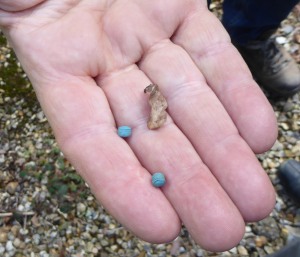

While we were looking about the biobead reactor area, one of our party found a few of the bright blue ridged biobeads on the ground. A little later, someone found a clutch of black knobbly biobeads on the ground near the parking area. This immediately answered the question about the source of the biobeads on Charmouth beach: despite what SWW had told us we now knew both black and blue biobeads were used at the Lyme Regis sewage works (Howells confirmed this) and were most likely escaping from the reactors to end up in the sea. I became very angry with Howells at this point; as I explained to him, we had spent so much time and energy trying to identify the source of the biobead pollution at Charmouth. South West Water had fed us contradictory stories, when all along they knew the source of the pollution which was their own sewage works.
Chemical analysis of pellets
The Cornish Plastic Pollution Coalition biobead story featured on a special edition of Inside Out South West on BBC TV in October 2018. The programme included visiting Dr Andrew Turner at the University of Plymouth where he had been analysing pellets for Claire Wallerstein for potentially toxic elements. I wondered if similar analysis might help understand the Charmouth blue pellets so I contacted Dr Turner. I was most grateful when he replied quickly and in the affirmative. I made two special collections, one at Dawlish Warren and another at Charmouth and I also sent him some of the black biobeads picked up at the Lyme Regis sewage works.
While this was in progress, Dr Turner along with Claire Wallerstein and Rob Arnold published a paper detailing X-ray fluorescence analyses of nurdles and black biobeads collected at a variety of locations in the south west (including Plympton sewage works and several Cornish beaches) and elsewhere along the English Channel. The technique identifies potentially toxic elements in the pellets and, whereas nurdles were usually devoid of these contaminants, the black biobeads contained varying quantities of lead, bromine, cadmium and antimony, a chemical signature characteristic of recycled electrical equipment containing flame retardants. Sometimes the levels exceeded permitted levels rendering the pellets toxic and potentially hazardous to life.
Black biobeads collected at Dawlish Warren, Charmouth and at Lyme Regis sewage works had the same chemical signature (bromine and antimony and sometimes lead and cadmium) as the black biobeads collected at Plympton sewage works and along Cornish beaches. This shows that the same black biobead is used by SWW at different sewage works and is escaping to end up on local beaches in Cornwall, Devon and Dorset. Nurdles found at Dawlish Warren and Charmouth (lentil shaped and smooth, cylindrical) did not hold any toxic element contamination whereas the blue biobeads found at Charmouth contained copper probably part of the blue pigment used to give the distinctive colour.
I am most grateful to Andrew Turner for supporting us by analysing these pellets.
Conclusions
- The source of the black and blue biobeads polluting Charmouth and West Bay beaches is the Lyme Regis sewage works run by South West Water where these pellets are escaping with treated sewage effluent to be discharged into the sea.
- The black biobead is the same pellet found along beaches in Devon and Dorset and in huge numbers on Cornish beaches, it is made from recycled electrical equipment and may contain toxic levels of trace elements. South West Water is responsible for this extensive pollution.
- Subsequent investigation found that the blue ridged biobead is also found at Burton Freshwater beach (a mile east of West Bay, found by Joe Hackett) and on the main sandy beach in Lyme Regis (about 2 miles west of Charmouth, found by Harry Dennis of Surfers Against Sewage). The pellets found on these beaches almost certainly come from the Lyme Regis sewage works
- One sample of pellets that I collected from Westcombe beach near Kingston in south Devon showed surprisingly large numbers of the blue ridged biobeads. Perhaps this can be explained by proximity to SWW’s biobead-dependent sewage works at Modbury.
- At Charmouth, West Bay and Lyme Regis, these biobeads are found in parts of the beach where children play in the summer. They are also found at Charmouth by the river where both gulls and ducks feed so it seems very likely that these birds will be accidentally ingesting pellets.
South West Water are installing extra filters at their biobead-dependent plants to minimise pellet loss as a result of the efforts of the Cornish Plastic Pollution Coalition. Providing that programme is completed and is successful, the number of biobeads on local beaches should diminish. This of course does not deal with the reservoir of biobeads now in the sea and also buried in sand. It is very difficult for me to see how these pellets can be cleaned up without damaging the fabric of the very beaches we wish to protect.
- Greater legal protection for the marine environment should be introduced so that companies like SWW who release biobeads, also plastics companies that release nurdles could be prosecuted for polluting seas and beaches.
I should like to express my thanks to everyone who helped bring this tortuous story to a conclusion.


An amazing story of perseverance and an example of what can be achieved. Well done. Amelia
LikeLike
Thanks, Amelia, it did at times feel like we would never reach a conclusion.
LikeLiked by 1 person
Thank you Philip for writing about the tortuous path we need to take when we try and fight back against those who are knowingly destroying Earth (and then lying to cover things up).
So many (all??) plastics, and other technical ‘solutions’ are really just shortcuts to avoid having to change our culture and address our place on a finite planet.
LikeLike
Thanks Nigel, it’s a pity that in this case if SWW had been a bit more careful with the pellets they wouldnt have run into all these problems.
LikeLike
Tortuous story indeed! I remember when you first wrote about the discovery of the mysterious nurdles, and I was very curious about them myself. I truly admire how tenacious you were in getting to the information you finally tracked down. What a hard job to get to the truth, but you and your fellow concerned activists have created an awareness that will undoubtedly lead to some measure of effective change. It is amazing how destructive plastics have become, endangering sea life and polluting our oceans and beaches. It will take all of us to be as aware and to follow whatever paths we can find to block unnecessary pollutants, but few people take the responsibility upon themselves as you have done. Thank you for this incredible update, Philip, and thank you for environmental leadership.
LikeLike
Thanks for your thoughtful comment and kind words, Debra.
LikeLiked by 1 person
Well done for being so persistent. After your first writing about the nurdles I looked on the beaches near us but I didn’t find any, plenty of other kinds of plastic waste though.
LikeLike
Thanks Christina, I had a look at the nurdle map (https://www.nurdlehunt.org.uk/take-part/nurdle-map.html) and there are a few reports for Italy. People do say that the English Channel is very polluted with pellets so perhaps you are relatively spared. What you find is also very dependent on the beach (sand/pebbles etc)
LikeLiked by 1 person
Ill keep looking
LikeLike
Please let me know if you find anything, I should be very interested to hear.
LikeLiked by 1 person
Certainly.
LikeLiked by 1 person
Congratulations on such a thorough research job and report. Sad news though for the local environment and wildlife.
LikeLike
Yes it is sad and so unnecessary.
LikeLiked by 1 person
Well done … yet, I’m stunned.
LikeLike
Thanks, Frank, I’m still stunned as well!
LikeLike
Thank you for all the time you spent investigating this story and trying to get to the bottom of it. We wouldn’t have gained so much knowledge of the issue without you.
LikeLike
Thanks for your kind words Sarah, in the end it was a joint effort and very good to meet so many committed people.
LikeLike
Great work! But feels overwhelming…
LikeLike
Yes, overwhelmed describes how I felt at times …….
LikeLiked by 1 person
Fantastic, dedicated ‘tec work, leaving no biobead unturned. SWW could could consider saving money and shame by simply renaming them ‘Ecobeads’. But it’s too late now…
LikeLike
Yes I like “ecobead” but it’s too late for SWW now, they are too deep in the shame.
LikeLike
I was swimming in the sea at Lyme Regis last month and noticed loads of these beads on the sand. Clearly the problem is still there! Disappointing.
LikeLike
Thanks for your comment and the information about the biobeads at Lyme. I havent been looking for a while but I wonder if your experience suggests that there is a huge reservoir of beads on the sea bed and they just wash up now and then. Depressing if its true.
LikeLike